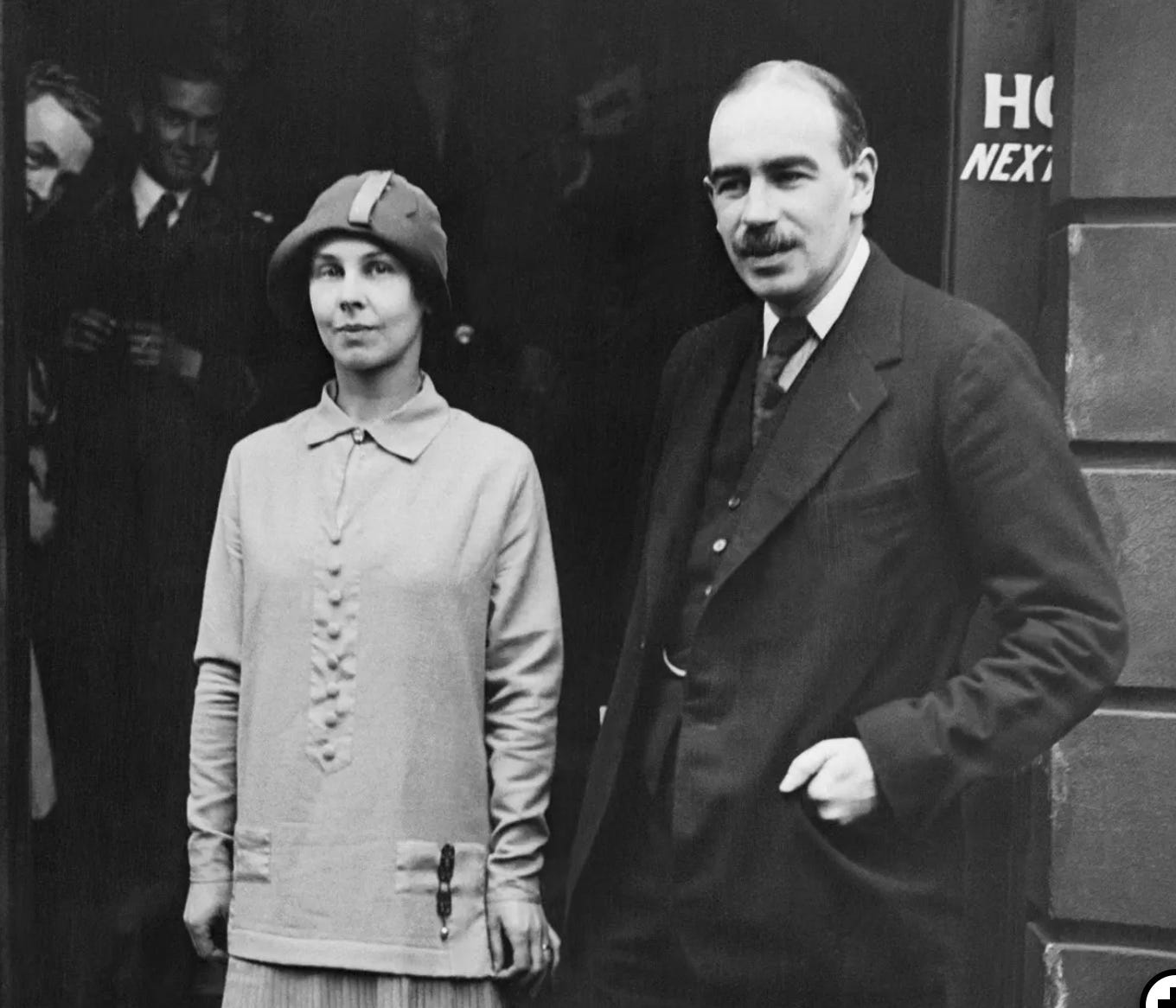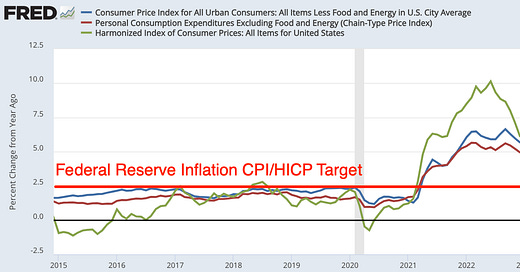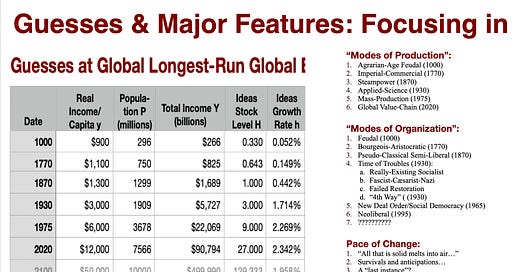
READING: John Maynard Keynes on Why the Business Cycle Is Cyclical
From Keynes's 1936 "General Theory of Employment, Interest, & Money, chapter 12...
From Keynes's 1936 "General Theory of Employment, Interest, & Money, chapter 12...
The overhang of excess inventories created by the fact of ongoing recession after a crash, and the likelihood that there will be no effective recovery in the perceived marginal efficiency of capital until enough time has passed for substantial capital depreciation to take place—those are the factors to which John Maynard Keynes back in 1936 attributed the complex root of the macroeconomic-output differential equation that is the cyclical part of the business cycle.
He attributed the magnitude of the cycle to the sizes of the shocks delivered by the recurrent sudden collapses of over-optimistic bubble-time expectations.
I think his reliance on pure expectational psychology here probably missed the mark to some considerable degree—financial market micro- and macro-structure matters a good deal here. As Robin Wigglesworth just wrote, you can say that in the pat month people have turned bearish on the dollar-yen, and in a sense they have, “but this more like a primal scream of margin calls, short-covering, and wrecked P&Ls to us”—Limits to Arbitrage with a Vengeance, starring Bruce Willis, Jeremy Irons, & Samuel L. Jackson:
Any fluctuation in investment not offset by a corresponding change in the propensity to consume will, of course, result in a fluctuation in employment. Since, therefore, the volume of investment is subject to highly complex influences, it is highly improbable that all fluctuations either in investment itself or in the marginal efficiency of capital will be of a cyclical character…. I suggest, however, that there are certain definite reasons why, in the case of a typical industrial trade cycle in the nineteenth-century environment, fluctuations in the marginal efficiency of capital should have had cyclical characteristics.
These reasons are by no means unfamiliar either in themselves or as explanations of the trade cycle. My only purpose here is to link them up with [my] preceding theory.
I can best introduce what I have to say by beginning with the later stages of the boom and the onset of the 'crisis'.
We have seen above that the marginal efficiency of capital depends, not only on the existing abundance or scarcity of capital-goods and the current cost of production of capital-goods, but also on current expectations as to the future yield of capital-goods. In the case of durable assets it is, therefore, natural and reasonable that expectations of the future should play a dominant part in determining the scale on which new investment is deemed advisable. But, as we have seen, the basis for such expectations is very precarious. Being based on shifting and unreliable evidence, they are subject to sudden and violent changes.
Now, we have been accustomed in explaining the 'crisis' to lay stress on the rising tendency of the rate of interest under the influence of the increased demand for money both for trade and speculative purposes. At times this factor may certainly play an aggravating and, occasionally perhaps, an initiating part. But I suggest that a more typical, and often the predominant, explanation of the crisis is, not primarily a rise in the rate of interest, but a sudden collapse in the marginal efficiency of capital.
The later stages of the boom are characterised by optimistic expectations as to the future yield of capitalgoods sufficiently strong to offset their growing abundance and their rising costs of production and, probably, a rise in the rate of interest also. It is of the nature of organised investment markets, under the influence of purchasers largely ignorant of what they are buying and of speculators who are more concerned with forecasting the next shift of market sentiment than with a reasonable estimate of the future yield of capital-assets, that, when disillusion falls upon an over-optimistic and over-bought market, it should fall with sudden and even catastrophic force.
Moreover, the dismay and uncertainty as to the future which accompanies a collapse in the marginal efficiency of capital naturally precipitates a sharp increase in liquidity-preference, and hence a rise in the rate of interest. Thus the fact that a collapse in the marginal efficiency of capital tends to be associated with a rise in the rate of interest may seriously aggravate the decline in investment. But the essence of the situation is to be found, nevertheless, in the collapse in the marginal efficiency of capital, particularly in the case of those types of capital which have been contributing most to the previous phase of heavy new investment.
Liquidity preference, except those manifestations of it which are associated with increasing trade and speculation, does not increase until after the collapse in the marginal efficiency of capital. It is this, indeed, which renders the slump so intractable. Later on, a decline in the rate of interest will be a great aid to recovery and, probably, a necessary condition of it. But, for the moment, the collapse in the marginal efficiency of capital may be so complete that no practicable reduction in the rate of interest will be enough.
If a reduction in the rate of interest was capable of proving an effective remedy by itself; it might be possible to achieve a recovery without the elapse of any considerable interval of time and by means more or less directly under the control of the monetary authority. But, in fact, this is not usually the case; and it is not so easy to revive the marginal efficiency of capital, determined, as it is, by the uncontrollable and disobedient psychology of the business world.
It is the return of confidence, to speak in ordinary language, which is so insusceptible to control in an economy of individualistic capitalism. This is the aspect of the slump which bankers and business men have been right in emphasising, and which the economists who have put their faith in a 'purely monetary' remedy have underestimated.
This brings me to my point.
The explanation of the time-element in the trade cycle, of the fact that an interval of time of a particular order of magnitude must usually elapse before recovery begins, is to be sought in the influences which govern the recovery of the marginal efficiency of capital. There are reasons, given firstly by the length of life of durable assets in relation to the normal rate of growth in a given epoch, and secondly by the carrying-costs of surplus stocks, why the duration of the downward movement should have an order of magnitude which is not fortuitous, which does not fluctuate between, say, one year this time and ten years next time, but which shows some regularity of habit between, let us say, three and five years.
Let us recur to what happens at the crisis.
So long as the boom was continuing, much of the new investment showed a not unsatisfactory current yield. The disillusion comes because doubts suddenly arise concerning the reliability of the prospective yield, perhaps because the current yield shows signs of falling off, as the stock of newly produced durable goods steadily increases. If current costs of production are thought to be higher than they will be later on, that will be a further reason for a fall in the marginal efficiency of capital. Once doubt begins it spreads rapidly. Thus at the outset of the slump there is probably much capital of which the marginal efficiency has become negligible or even negative. But the interval of time, which will have to elapse before the shortage of capital through use, decay and obsolescence causes a sufficiently obvious scarcity to increase the marginal efficiency, may be a somewhat stable function of the average durability of capital in a given epoch.
If the characteristics of the epoch shift, the standard time-interval will change. If, for example, we pass from a period of increasing population into one of declining population, the characteristic phase of the cycle will be lengthened. But we have in the above a substantial reason why the duration of the slump should have a definite relationship to the length of life of durable assets and to the normal rate of growth in a given epoch.
The second stable time-factor is due to the carrying-costs of surplus stocks which force their absorption within a certain period, neither very short nor very long. The sudden cessation of new investment after the crisis will probably lead to an accumulation of surplus stocks of unfinished goods. The carrying costs of these stocks will seldom be less than 10 per cent. per annum. Thus the fall in their price needs to be sufficient to bring about a restriction which provides for their absorption within a period of; say, three to five years at the outside. Now the process of absorbing the stocks represents negative investment, which is a further deterrent to employment; and, when it is over, a manifest relief will be experienced.
Moreover, the reduction in working capital, which is necessarily attendant on the decline in output on the downward phase, represents a further element of disinvestment, which may be large; and, once the recession has begun, this exerts a strong cumulative influence in the downward direction. In the earliest phase of a typical slump there will probably be an investment in increasing stocks which helps to offset disinvestment in working-capital; in the next phase there may be a short period of disinvestment both in stocks and in working-capital; after the lowest point has been passed there is likely to be a further disinvestment in stocks which partially offsets reinvestment in working-capital; and, finally, after the recovery is well on its way, both factors will be simultaneously favourable to investment.
It is against this background that the additional and superimposed effects of fluctuations of investment in durable goods must be examined. When a decline in this type of investment has set a cyclical fluctuation in motion there will be little encouragement to a recovery in such investment until the cycle has partly run its course.
Unfortunately a serious fall in the marginal efficiency of capital also tends to affect adversely the propensity to consume. For it involves a severe decline in the market value of stock exchange equities. Now, on the class who take an active interest in their stock exchange investments, especially if they are employing borrowed funds, this naturally exerts a very depressing influence. These people are, perhaps, even more influenced in their readiness to spend by rises and falls in the value of their investments than by the state of their incomes. With a 'stock-minded' public as in the United States to-day, a rising stockmarket may be an almost essential condition of a satisfactory propensity to consume; and this circumstance, generally overlooked until lately, obviously serves to aggravate still further the depressing effect of a decline in the marginal efficiency of capital.
When once the recovery has been started, the manner in which it feeds on itself and cumulates is obvious. But during the downward phase, when both fixed capital and stocks of materials are for the time being redundant and working-capital is being reduced, the schedule of the marginal efficiency of capital may fall so low that it can scarcely be corrected, so as to secure a satisfactory rate of new investment, by any practicable reduction in the rate of interest. Thus with markets organised and influenced as they are at present, the market estimation of the marginal efficiency of capital may suffer such enormously wide fluctuations that it cannot be sufficiently offset by corresponding fluctuations in the rate of interest.
Moreover, the corresponding movements in the stock-market may, as we have seen above, depress the propensity to consume just when it is most needed.
In conditions of laissez-faire the avoidance of wide fluctuations in employment may, therefore, prove impossible without a far-reaching change in the psychology of investment markets such as there is no reason to expect.
I conclude that the duty of ordering the current volume of investment cannot safely be left in private hands.
The preceding analysis may appear to be in conformity with the view of those who hold that overinvestment is the characteristic of the boom, that the avoidance of this over-investment is the only possible remedy for the ensuing slump, and that, whilst for the reasons given above the slump cannot be prevented by a low rate of interest, nevertheless the boom can be avoided by a high rate of interest. There is, indeed, force in the argument that a high rate of interest is much more effective against a boom than a low rate of interest against a slump. To infer these conclusions from the above would, however, misinterpret my analysis; and would, according to my way of thinking, involve serious error. For the term over-investment is ambiguous. It may refer to investments which are destined to disappoint the expectations which prompted them or for which there is no use in conditions of severe unemployment, or it may indicate a state of affairs where every kind of capital-goods is so abundant that there is no new investment which is expected, even in conditions of full employment, to earn in the course of its life more than its replacement cost. It is only the latter state of affairs which is one of over-investment, strictly speaking, in the sense that any further investment would be a sheer waste of resources.
Moreover, even if over-investment in this sense was a normal characteristic of the boom, the remedy would not lie in clapping on a high rate of interest which would probably deter some useful investments and might further diminish the propensity to consume, but in taking drastic steps, by redistributing incomes or otherwise, to stimulate the propensity to consume.
According to my analysis, however, it is only in the former sense that the boom can be said to be characterised by over-investment. The situation, which I am indicating as typical, is not one in which capital is so abundant that the community as a whole has no reasonable use for any more, but where investment is being made in conditions which are unstable and cannot endure, because it is prompted by expectations which are destined to disappointment.
It may, of course, be the case—indeed it is likely to be—that the illusions of the boom cause particular types of capital-assets to be produced in such excessive abundance that some part of the output is, on any criterion, a waste of resources; which sometimes happens, we may add, even when there is no boom. It leads, that is to say, to misdirected investment. But over and above this it is an essential characteristic of the boom that investments which will in fact yield, say, 2 per cent in conditions of full employment are made in the expectation of a yield of; say, 6 per cent, and are valued accordingly.
When the disillusion comes, this expectation is replaced by a contrary 'error of pessimism', with the result that the investments, which would in fact yield 2 per cent in conditions of full employment, are expected to yield less than nothing; and the resulting collapse of new investment then leads to a state of unemployment in which the investments, which would have yielded 2 per cent in conditions of full employment, in fact yield less than nothing.
We reach a condition where there is a shortage of houses, but where nevertheless no one can afford to live in the houses that there are.
Thus the remedy for the boom is not a higher rate of interest but a lower rate of interest! For that may enable the so-called boom to last. The right remedy for the trade cycle is not to be found in abolishing booms and thus keeping us permanently in a semi-slump; but in abolishing slumps and thus keeping us permanently in a quasi-boom. The boom which is destined to end in a slump is caused, therefore, by the combination of a rate of interest, which in a correct state of expectation would be too high for full employment, with a misguided state of expectation which, so long as it lasts, prevents this rate of interest from being in fact deterrent. A boom is a situation in which over-optimism triumphs over a rate of interest which, in a cooler light, would be seen to be excessive.
Except during the war, I doubt if we have any recent experience of a boom so strong that it led to full employment. In the United States employment was very satisfactory in 1928−29 on normal standards; but I have seen no evidence of a shortage of labour, except, perhaps, in the case of a few groups of highly specialised workers. Some 'bottle-necks' were reached, but output as a whole was still capable of further expansion. Nor was there over-investment in the sense that the standard and equipment of housing was so high that everyone, assuming full employment, had all he wanted at a rate which would no more than cover the replacement cost, without any allowance for interest, over the life of the house; and that transport, public services and agricultural improvement had been carried to a point where further additions could not reasonably be expected to yield even their replacement cost.
Quite the contrary.
It would be absurd to assert of the United States in 1929 the existence of over-investment in the strict sense. The true state of affairs was of a different character. New investment during the previous five years had been, indeed, on so enormous a scale in the aggregate that the prospective yield of further additions was, coolly considered, falling rapidly. Correct foresight would have brought down the marginal efficiency of capital to an unprecedentedly low figure; so that the 'boom' could not have continued on a sound basis except with a very low long-term rate of interest, and an avoidance of misdirected investment in the particular directions which were in danger of being over-exploited. In fact, the rate of interest was high enough to deter new investment except in those particular directions which were under the influence of speculative excitement and, therefore, in special danger of being overexploited; and a rate of interest, high enough to overcome the speculative excitement, would have checked, at the same time, every kind of reasonable new investment.
Thus an increase in the rate of interest, as a remedy for the state of affairs arising out of a prolonged period of abnormally heavy new investment, belongs to the species of remedy which cures the disease by killing the patient. It is, indeed, very possible that the prolongation of approximately full employment over a period of years would be associated in countries so wealthy as Great Britain or the United States with a volume of new investment, assuming the existing propensity to consume, so great that it would eventually lead to a state of full investment in the sense that an aggregate gross yield in excess of replacement cost could no longer be expected on a reasonable calculation from a further increment of durable goods of any type whatever. Moreover, this situation might be reached comparatively soon—say within twenty-five years or less. I must not be taken to deny this, because I assert that a state of full investment in the strict sense has never yet occurred, not even momentarily.
Furthermore, even if we were to suppose that contemporary booms are apt to be associated with a momentary condition of full investment or over-investment in the strict sense, it would still be absurd to regard a higher rate of interest as the appropriate remedy. For in this event the case of those who attribute the disease to under-consumption would be wholly established. The remedy would lie in various measures designed to increase the propensity to consume by the redistribution of incomes or otherwise; so that a given level of employment would require a smaller volume of current investment to support it…
References:
DeLong, J. Bradford, Andrei Shleifer, Lawrence H. Summers, & Robert J. Waldmann. 1990. "Noise Trader Risk in Financial Markets." Journal of Political Economy 98 (4): 703-738. <https://www.jstor.org/stable/2937765>.
Keynes, John Maynard. 1936. The General Theory of Employment, Interest & Money. London: Macmillan and Co., Ltd. <https://archive.org/details/generaltheoryofe00keyn>.
McTiernan, John, Dir.. 1995. Die Hard with a Vengeance. Los Angeles: 20th Century Fox. <https://www.paramountplus.com/movies/video/xlHh2M53LlKUTyA8PKz_CqqNBqTkflUd/>.
Shleifer, Andrei, & Robert W. Vishny. 1997. "The Limits of Arbitrage." Journal of Finance 52 (1): 35-55. <https://www.jstor.org/stable/2329555>.

















Is it Keynes or I that have the problem? I find his sentences stuffed with more concepts/ideas than my poor peabrain can decipher. I suffer from NASA brain where you don't put more than 3 points on a slide.
"We reach a condition where there is a shortage of houses, but where nevertheless no one can afford to live in the houses that there are." Sounds familiar!